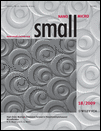Biotemplated Metal Nanowires Using Hyperthermophilic Protein Filaments†
Joseph M. Slocik
Nanostructured and Biological Materials Branch Materials and Manufacturing Directorate Air Force Research Lab Wright-Patterson AFB OH 45433–7750 (USA)
Search for more papers by this authorSang Nyon Kim
Nanostructured and Biological Materials Branch Materials and Manufacturing Directorate Air Force Research Lab Wright-Patterson AFB OH 45433–7750 (USA)
Search for more papers by this authorTimothy A. Whitehead
Department of Chemical Engineering University of California, Berkeley CA 94720 (USA)
Search for more papers by this authorDouglas S. Clark
Department of Chemical Engineering University of California, Berkeley CA 94720 (USA)
Search for more papers by this authorCorresponding Author
Rajesh R. Naik
Nanostructured and Biological Materials Branch Materials and Manufacturing Directorate Air Force Research Lab Wright-Patterson AFB OH 45433–7750 (USA)
Nanostructured and Biological Materials Branch Materials and Manufacturing Directorate Air Force Research Lab Wright-Patterson AFB OH 45433–7750 (USA).Search for more papers by this authorJoseph M. Slocik
Nanostructured and Biological Materials Branch Materials and Manufacturing Directorate Air Force Research Lab Wright-Patterson AFB OH 45433–7750 (USA)
Search for more papers by this authorSang Nyon Kim
Nanostructured and Biological Materials Branch Materials and Manufacturing Directorate Air Force Research Lab Wright-Patterson AFB OH 45433–7750 (USA)
Search for more papers by this authorTimothy A. Whitehead
Department of Chemical Engineering University of California, Berkeley CA 94720 (USA)
Search for more papers by this authorDouglas S. Clark
Department of Chemical Engineering University of California, Berkeley CA 94720 (USA)
Search for more papers by this authorCorresponding Author
Rajesh R. Naik
Nanostructured and Biological Materials Branch Materials and Manufacturing Directorate Air Force Research Lab Wright-Patterson AFB OH 45433–7750 (USA)
Nanostructured and Biological Materials Branch Materials and Manufacturing Directorate Air Force Research Lab Wright-Patterson AFB OH 45433–7750 (USA).Search for more papers by this authorThis research was performed while S.N. held a National Research Council Research Associateship Award at AFRL. The authors thank Dr. C. Devlin for the microlithography process.
Graphical Abstract
Supporting Information
Detailed facts of importance to specialist readers are published as ”Supporting Information”. Such documents are peer-reviewed, but not copy-edited or typeset. They are made available as submitted by the authors.
| Filename | Description |
|---|---|
| smll_200900499_sm_supplfigs.pdf630.7 KB | supplfigs |
Please note: The publisher is not responsible for the content or functionality of any supporting information supplied by the authors. Any queries (other than missing content) should be directed to the corresponding author for the article.
References
- 1 Encyclopedia of Nanoscience and Nanotechnology, Vol. 2–3(Ed.: H. S. Nalwa), American Scientific Publishers, Valencia 2004.
- 2 W. Lu, C. M. Lieber, Nat. Mater. 2007, 6, 841–850.
- 3 M. B. Dickerson, K. H. Sandhage, R. R. Naik, Chem. Rev. 2008, 108, 4935–4978.
- 4 H. Yan, S. H. Park, G. Finkelstein, J. H. Reif, T. H. LaBean, Science 2003, 301, 1882–1884.
- 5 T. Nishinaka, A. Takano, Y. Doi, M. Hashimoto, A. Nakamura, Y. Matsushita, J. Kumaki, E. Yashima, J. Am. Chem. Soc. 2005, 127, 8120–8125.
- 6 E. Dujardin, C. Peet, G. Stubbs, J. N. Culver, S. Mann, Nano Lett. 2003, 3, 413–417.
- 7 R. Djalali, Y.-f Chen,, H. Matsui, J. Am. Chem. Soc. 2002, 124, 13660–13661.
- 8 I. A. Banerjee, L. Yu, H. Matsui, Proc. Natl. Acad. Sci. USA 2003, 100, 14678–14682.
- 9 S. S. Bale, P. Asuri, S. S. Karajanagi, J. S. Dordick, R. S. Kane, Adv. Mater. 2007, 19, 3167–3170.
- 10 T. Scheibel, R. Parthasarathy, G. Sawicki, X.-M. Lin, H. Jaeger, S. L. Lindquist, Proc. Natl. Acad. Sci. U. S. A. 2003, 100, 4527–4532.
- 11 C. Wang, Y. Hu, C. M. Lieber, S. Sun, J. Am. Chem. Soc. 2008, 130, 8902–8903.
- 12 T. A. Whitehead, A. L. Meadows, D. S. Clark, Small 2008, 4, 956–960.
- 13 T. A. Whitehead, B. B. Boonyaratanakornkit, V. Hollrigl, D. S. Clark, Protein Sci. 2007, 16, 626–634.
- 14 J. Xie, J. Y. Lee, D. I. C. Wang, J. Phys. Chem. C. 2007, 111, 10226–10232.
- 15 J. M. Slocik, J. T. Moore, D. W. Wright, Nano Lett. 2002, 2, 169–173.
- 16 R. R. Bhattacharjee, A. K. Das, D. Haldar, S. Si, A. Banerjee, T. K. Mandal, J. Nanosci. Nanotechnol. 2005, 5, 1141–1147.
- 17 A. R. Bassindale, A. Codina-Barrios, N. Frascione, P. G. Taylor, Chem. Commun. 2007, 2956–2958.
- 18 M. T. Kumara, B. C. Tripp, S. Muralidharan, Chem. Mater. 2007, 19, 2056–2064.
- 19 R. R. Naik, S. E. Jones, C. J. Murray, J. C. McAuliffe, R. A. Vaia, M. O. Stone, Adv. Funct. Mater. 2004, 14, 25–30.
- 20 T. Klaus, R. Joerger, E. Olsson, C. G. Granqvist, Proc. Natl. Acad. Sci. USA 1999, 96, 13611–13614.
- 21 A. Rangnekar, T. K. Sarma, A. K. Singh, J. Deka, A. Ramesh, A. Chattopadhyay, Langmuir 2007, 23, 5700–5706.
- 22 I. Willner, R. Baron, B. Willner, Adv. Mater. 2006, 18, 1109–1120.
- 23 B. Liu, J. Xie, J. Y. Lee, Y. P. Ting, J. P. Chen, J. Phys. Chem. B 2005, 109, 15256–15263.
- 24 S. Kundu, H. Liang, Langmuir 2008, 24, 9668–9674.
- 25 R. W. J. Scott, C. Sivadinarayana, O. M. Wilson, Z. Yan, D. W. Goodman, R. M. Crooks, J. Am. Chem. Soc. 2005, 127, 1380–1381.
- 26 J. M. Slocik, R. R. Naik, Adv. Mater. 2006, 18, 1988–1992.
- 27 Z. Ge, D. G. Cahill, P. V. Braun, J. Phys. Chem. B 2004, 108, 18870–18875.
- 28 S. T. Patton, J. M. Slocik, A. Campbell, J. Hu, R. Naik, A. A. Voevodin, Nanotechnology 2008, 19, 405705.





